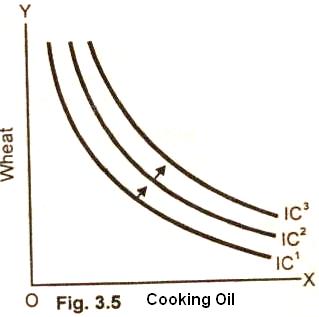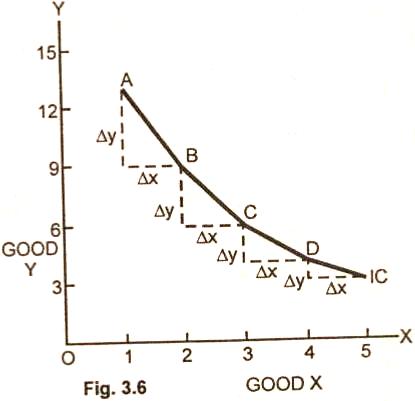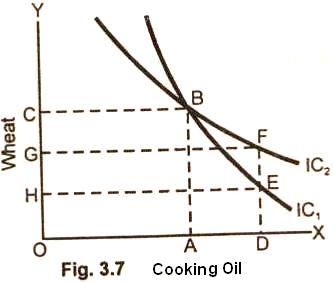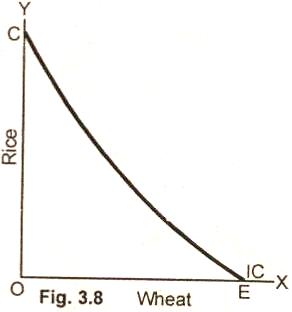Properties/Characteristics of Indifference
Curve:
Definition, Explanation and
Diagram:
An
indifference curve shows combination of goods between which a person is
indifferent. The main attributes or properties or characteristics of
indifference curves are as follows:
(1)
Indifference Curves are Negatively Sloped:
The indifference curves must
slope down from left to right. This means that an indifference curve is
negatively sloped. It slopes downward because as the consumer increases the
consumption of X commodity, he has to give up certain units of Y commodity in
order to maintain the same level of satisfaction.

In fig. 3.4
the two combinations of commodity cooking oil and commodity wheat is
shown by the points a and b on the same indifference curve. The consumer is
indifferent towards points a and b as they represent equal level of
satisfaction.
At point (a) on the indifference curve, the consumer is satisfied
with OE units of ghee and OD units of wheat. He is equally satisfied with OF
units of ghee and OK units of wheat shown by point b on the indifference curve.
It is only on the negatively sloped curve that different points representing
different combinations of goods X and Y give the same level of satisfaction to
make the consumer indifferent.
(2)
Higher Indifference Curve Represents Higher Level:
A higher indifference
curve that lies above and to the right of another indifference curve represents
a higher level of satisfaction and combination on a lower indifference curve
yields a lower satisfaction.
In other
words, we can say that the combination of goods which lies on a higher
indifference curve will be preferred by a consumer to the combination which lies
on a lower indifference curve.

In this
diagram (3.5) there are three indifference curves, IC1, IC2 and IC3 which
represents different levels of satisfaction. The indifference curve IC3 shows
greater amount of satisfaction and it contains more of both goods than IC2 and
IC1 (IC3 > IC2 > IC1).
(3)
Indifference Curve are Convex to the Origin:
This is an important property
of indifference curves. They are convex to the origin (bowed inward). This is
equivalent to saying that as the consumer substitutes commodity X for commodity
Y, the marginal rate of substitution diminishes of X for Y along an indifference
curve.

In this
figure (3.6) as the consumer moves from A to B to C to D, the willingness to
substitute good X for good Y diminishes. This means that as the amount of good X
is increased by equal amounts, that of good Y diminishes by smaller amounts. The
marginal rate of substitution of X for Y is the quantity of Y good that the
consumer is willing to give up to gain a marginal unit of good X. The slope of
IC is negative. It is convex to the origin.
(4) Indifference Curve Cannot
Intersect Each Other:
Given the definition of
indifference curve and the assumptions behind it, the indifference curves cannot
intersect each other. It is because at the point of tangency, the higher curve
will give as much as of the two commodities as is given by the lower
indifference curve. This is absurd and impossible.

In fig 3.7,
two indifference curves are showing cutting each other at point B. The
combinations represented by points B and F given equal satisfaction to the
consumer because both lie on the same indifference curve IC2. Similarly the
combinations shows by points B and E on indifference curve IC1 give equal
satisfaction top the consumer.
If
combination F is equal to combination B in terms of satisfaction and combination
E is equal to combination B in satisfaction. It follows that the combination F
will be equivalent to E in terms of satisfaction. This conclusion looks quite
funny because combination F on IC2 contains more of good Y (wheat) than
combination which gives more satisfaction to the consumer. We, therefore,
conclude that indifference curves cannot cut each other.
(5) Indifference Curves do not
Touch the Horizontal or Vertical Axis:
One of the
basic assumptions of indifference curves is that the consumer purchases
combinations of different commodities. He is not supposed to purchase only one
commodity. In that case indifference curve will touch one axis. This violates
the basic assumption of indifference curves.

In fig. 3.8,
it is shown that the in difference IC touches Y axis at point C and X axis at
point E. At point C, the consumer purchase only OC commodity of rice and no
commodity of wheat, similarly at point E, he buys OE quantity of wheat and no
amount of rice. Such indifference curves are against our basic assumption. Our
basic assumption is that the consumer buys two goods in combination.
Relevant Articles:
|